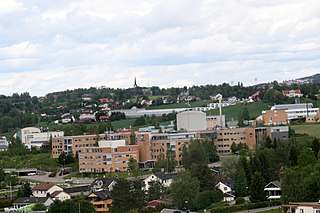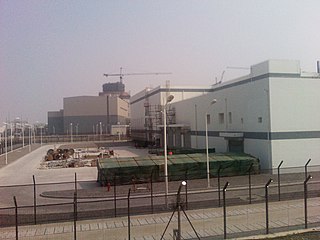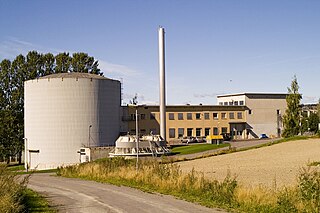No nuclear power plant has ever been established in Norway; however, the country has a legal framework for licensing the construction and operation of nuclear installations. [1] Also, four research reactors have been built in Norway. The four reactors were located in Kjeller and Halden and were as follows:
In 2019, Norway's last remaining nuclear reactor left in operation, the JEEP II reactor at Kjeller, was shut down after more than 50 years of service. [2] [3] In 2021, the Norwegian Green Party stated their support for development of nuclear energy as an alternative source of energy in order to reach the IPCC's goal of preventing global warming by 1.5 degrees. [4]
In 2020 it was estimated dismantling the Halden and Kjeller research reactors and restoring the sites to unrestricted use will cost about NOK20 billion (US$2 billion) and take 20 to 25 years. [5]
There has been discussions about the possible usage of nuclear energy, which is supported by some industry leaders. [6] Statkraft together with Vattenfall, Fortum and the energy investment company Scatec announced plans to investigate building of a thorium-fueled power plant in 2007 which was never realized. [7] In 2010, Aker Solutions purchased patents from Nobel Prize winning physicist Carlo Rubbia for the design of a proton accelerator-based thorium nuclear power plant, [8] but was subsequently sold to Jacobs Engineering Group in 2011. [9] In late 2012, Norway's privately owned Thor Energy, in collaboration with the government and Westinghouse, announced a four-year trial using thorium in an existing nuclear reactor. [10]

Carlo Rubbia is an Italian particle physicist and inventor who shared the Nobel Prize in Physics in 1984 with Simon van der Meer for work leading to the discovery of the W and Z particles at CERN.

Kjeller is a village located near Lillestrøm in the municipality of Lillestrøm, Norway. It is located 25 kilometers north-east of Oslo.

British Nuclear Fuels Limited (BNFL) was a nuclear energy and fuels company owned by the UK Government. It was a manufacturer of nuclear fuel, ran reactors, generated and sold electricity, reprocessed and managed spent fuel, and decommissioned nuclear plants and other similar facilities.
Atomic Energy of Canada Limited (AECL) is a Canadian federal Crown corporation and Canada's largest nuclear science and technology laboratory. AECL developed the CANDU reactor technology starting in the 1950s, and in October 2011 licensed this technology to Candu Energy.
In nuclear physics, an energy amplifier is a novel type of nuclear power reactor, a subcritical reactor, in which an energetic particle beam is used to stimulate a reaction, which in turn releases enough energy to power the particle accelerator and leave an energy profit for power generation. The concept has more recently been referred to as an accelerator-driven system (ADS) or accelerator-driven sub-critical reactor.
The Alvin W. Vogtle Electric Generating Plant, also known as Plant Vogtle, is a four-unit nuclear power plant located in Burke County, near Waynesboro, Georgia, in the southeastern United States.

The Shippingport Atomic Power Station was the world's first full-scale atomic electric power plant devoted exclusively to peacetime uses. It was located near the present-day Beaver Valley Nuclear Generating Station on the Ohio River in Beaver County, Pennsylvania, United States, about 25 miles (40 km) from Pittsburgh.

The AP1000 is a nuclear power plant designed and sold by Westinghouse Electric Company. The plant is a pressurized water reactor with improved use of passive nuclear safety and many design features intended to lower its capital cost and improve its economics.
The advanced heavy-water reactor (AHWR) or AHWR-300 is the latest Indian design for a next-generation nuclear reactor that burns thorium in its fuel core. It is slated to form the third stage in India's three-stage fuel-cycle plan. This phase of the fuel cycle plan was supposed to be built starting with a 300MWe prototype in 2016.
The electricity sector in Sweden has three operational nuclear power plants with 6 operational nuclear reactors, which produce about 29.8% of the country's electricity. The nation's largest power station, Forsmark Nuclear Power Plant, has three reactors producing 3.3 GW and 14% of Sweden's electricity.

Nuclear power was used in Germany from the 1960s until being phased out on April 2023.

The Sanmen Nuclear Power Station is a nuclear power station in Sanmen County, Zhejiang, China. Sanmen is the first implementation of the AP1000 pressurized water reactor (PWR) developed by Westinghouse Electric Company.

Ukraine operates four nuclear power plants with 15 reactors located in Volhynia and South Ukraine. The total installed nuclear power capacity is over 13 GWe, ranking 7th in the world in 2020. Energoatom, a Ukrainian state enterprise, operates all four active nuclear power stations in Ukraine. In 2019, nuclear power supplied over 20% of Ukraine's energy.

Institute for Energy Technology (IFE) was established in 1948 as the Institute for Nuclear Energy (IFA). The name was changed in 1980. Its main office is at Kjeller, Norway, and slightly under half of the institute’s activities are based in Halden. In Halden IFE is host to the international OECD Halden Reactor Project, with 18 member states.
Denmark imports but does not produce nuclear energy, which is in accordance with a 1985 law passed by the Danish parliament, prohibiting power production from nuclear energy in Denmark. In 2014 and 2015, (imported) nuclear power was 3-4% of electricity consumption in Denmark.

The Halden Reactor was a 25MW (thermal) nuclear reactor located in Halden, Norway and dedicated for research. Construction started 1955 and the reactor became operative in 1958, and was operated by the Institute for Energy Technology (IFE). The reactor was built into bedrock at 100 meters depth.
An accelerator-driven subcritical reactor (ADSR) is a nuclear reactor design formed by coupling a substantially subcritical nuclear reactor core with a high-energy proton or electron accelerator. It could use thorium as a fuel, which is more abundant than uranium.

Thorium-based nuclear power generation is fueled primarily by the nuclear fission of the isotope uranium-233 produced from the fertile element thorium. A thorium fuel cycle can offer several potential advantages over a uranium fuel cycle—including the much greater abundance of thorium found on Earth, superior physical and nuclear fuel properties, and reduced nuclear waste production. One advantage of thorium fuel is its low weaponization potential; it is difficult to weaponize the uranium-233/232 and plutonium-238 isotopes that are largely consumed in thorium reactors.
The international Thorium Energy Committee (iThEC) was founded in late 2012 at CERN in Geneva by scientists, engineers, political figures and industrialists under the leadership of its honorary president Carlo Rubbia, to promote the cause of using thorium as a means of reducing existing and future nuclear waste, and also for generating electricity.
JEEP II was a research reactor in Kjeller, Norway that was in operation between 1966 and 2018. The reactor was operated by the Institute for Energy Technology (IFE). Construction of JEEP II began in 1965, and the reactor went critical for the first time in December 1966.